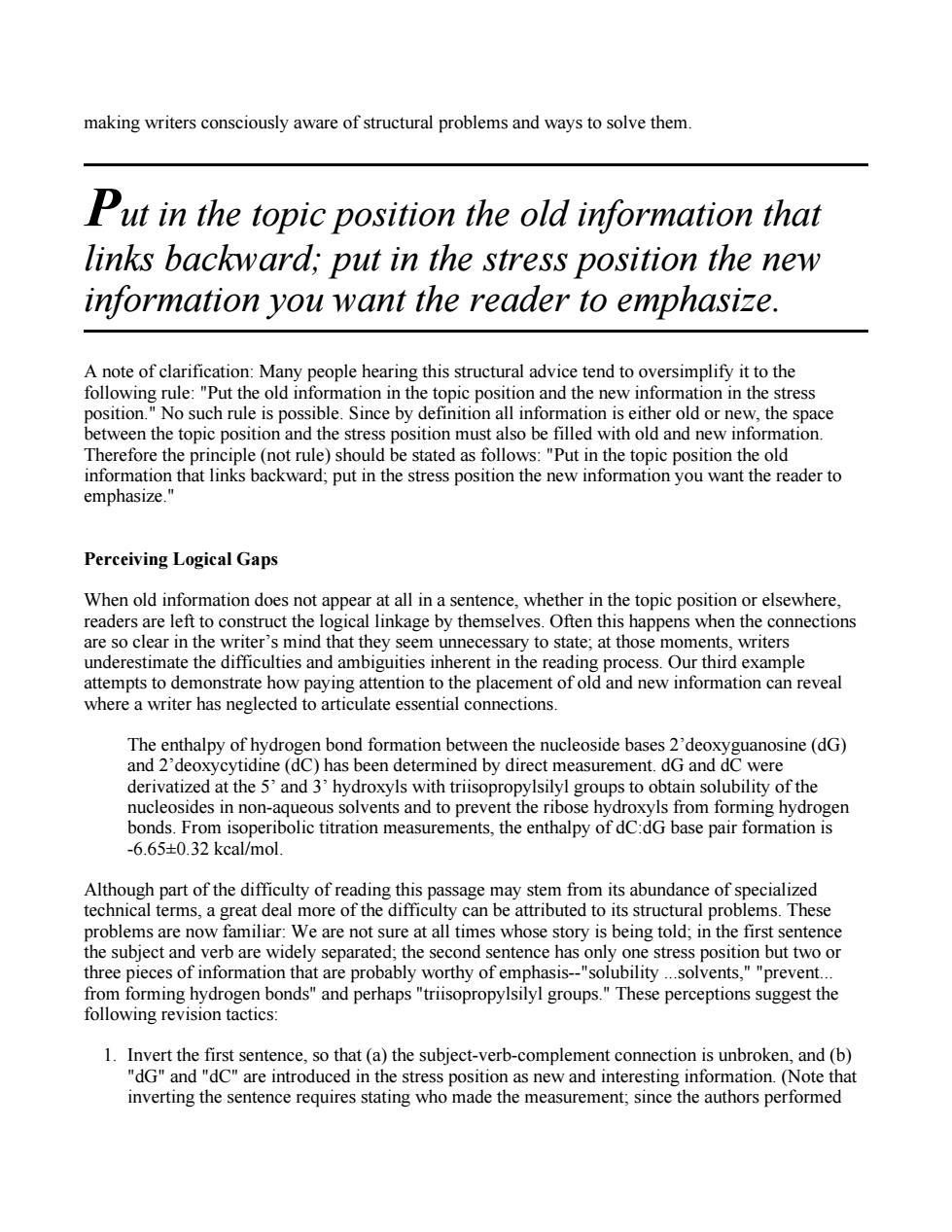正在加载图片...

making writers consciously aware of structural problems and ways to solve them. Put in the topic position the old information that links backward;put in the stress position the new information you want the reader to emphasize. A note of clarification:Many people hearing this structural advice tend to oversimplify it to the following rule:"Put the old information in the topic position and the new information in the stress position.No such rule is possible.Since by definition all information is either old or new,the space between the topic position and the stress position must also be filled with old and new information. Therefore the principle(not rule)should be stated as follows:"Put in the topic position the old information that links backward;put in the stress position the new information you want the reader to emphasize." Perceiving Logical Gaps When old information does not appear at all in a sentence,whether in the topic position or elsewhere, readers are left to construct the logical linkage by themselves.Often this happens when the connections are so clear in the writer's mind that they seem unnecessary to state;at those moments,writers underestimate the difficulties and ambiguities inherent in the reading process.Our third example attempts to demonstrate how paying attention to the placement of old and new information can reveal where a writer has neglected to articulate essential connections. The enthalpy of hydrogen bond formation between the nucleoside bases 2'deoxyguanosine(dG) and 2'deoxycytidine(dC)has been determined by direct measurement.dG and dC were derivatized at the 5'and 3hydroxyls with triisopropylsilyl groups to obtain solubility of the nucleosides in non-aqueous solvents and to prevent the ribose hydroxyls from forming hydrogen bonds.From isoperibolic titration measurements,the enthalpy of dC:dG base pair formation is -6.65±0.32kcal/mol. Although part of the difficulty of reading this passage may stem from its abundance of specialized technical terms,a great deal more of the difficulty can be attributed to its structural problems.These problems are now familiar:We are not sure at all times whose story is being told;in the first sentence the subject and verb are widely separated;the second sentence has only one stress position but two or three pieces of information that are probably worthy of emphasis--"solubility...solvents,""prevent... from forming hydrogen bonds"and perhaps "triisopropylsilyl groups."These perceptions suggest the following revision tactics: 1.Invert the first sentence,so that(a)the subject-verb-complement connection is unbroken,and(b) "dG"and "dC"are introduced in the stress position as new and interesting information.(Note that inverting the sentence requires stating who made the measurement;since the authors performedmaking writers consciously aware of structural problems and ways to solve them. Put in the topic position the old information that links backward; put in the stress position the new information you want the reader to emphasize. A note of clarification: Many people hearing this structural advice tend to oversimplify it to the following rule: "Put the old information in the topic position and the new information in the stress position." No such rule is possible. Since by definition all information is either old or new, the space between the topic position and the stress position must also be filled with old and new information. Therefore the principle (not rule) should be stated as follows: "Put in the topic position the old information that links backward; put in the stress position the new information you want the reader to emphasize." Perceiving Logical Gaps When old information does not appear at all in a sentence, whether in the topic position or elsewhere, readers are left to construct the logical linkage by themselves. Often this happens when the connections are so clear in the writer’s mind that they seem unnecessary to state; at those moments, writers underestimate the difficulties and ambiguities inherent in the reading process. Our third example attempts to demonstrate how paying attention to the placement of old and new information can reveal where a writer has neglected to articulate essential connections. The enthalpy of hydrogen bond formation between the nucleoside bases 2’deoxyguanosine (dG) and 2’deoxycytidine (dC) has been determined by direct measurement. dG and dC were derivatized at the 5’ and 3’ hydroxyls with triisopropylsilyl groups to obtain solubility of the nucleosides in non-aqueous solvents and to prevent the ribose hydroxyls from forming hydrogen bonds. From isoperibolic titration measurements, the enthalpy of dC:dG base pair formation is -6.65±0.32 kcal/mol. Although part of the difficulty of reading this passage may stem from its abundance of specialized technical terms, a great deal more of the difficulty can be attributed to its structural problems. These problems are now familiar: We are not sure at all times whose story is being told; in the first sentence the subject and verb are widely separated; the second sentence has only one stress position but two or three pieces of information that are probably worthy of emphasis--"solubility ...solvents," "prevent... from forming hydrogen bonds" and perhaps "triisopropylsilyl groups." These perceptions suggest the following revision tactics: 1. Invert the first sentence, so that (a) the subject-verb-complement connection is unbroken, and (b) "dG" and "dC" are introduced in the stress position as new and interesting information. (Note that inverting the sentence requires stating who made the measurement; since the authors performed